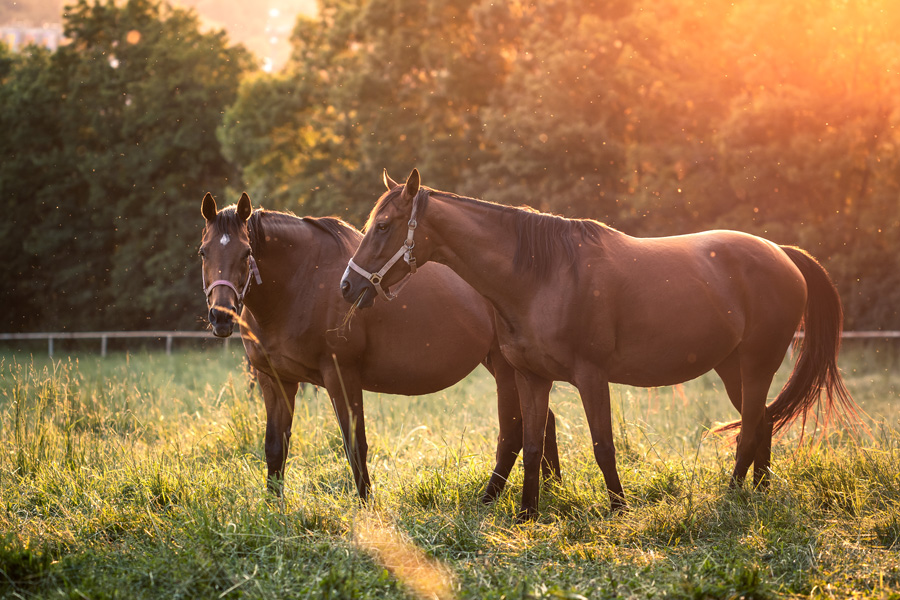Animal Production
-

Parasite resistance is an increasing problem in livestock species, including horses. Equine deworming practices have historically involved a six-week rotational deworming schedule. However, these practices have led to parasite resistance to many of our available dewormers. This publication addresses the current recommendations for deworming based on fecal egg counts, including why parasite resistance is increasing and how and when to assess fecal egg counts in horses.
Kylee Jo Duberstein
|
-

C 1207
Halter Training Beef Cattle
If you or someone you know is planning to halter train beef cattle, remember that the calf must be coached—it will not instinctively know what to do. Good coaching equals better results. This circular focuses on how to be a good coach during the halter training process for beef cattle.
Carole Knight, Justin Hand, and Jason Duggin
|
-

Feeder cattle buyers, marketers, and producers are able to communicate the potential growth and carcass merit potential of individual and grouped calves using the USDA Feeder Cattle Grading Standards. Producers that are aware of these standards and their use in predicting carcass value are better suited to making breeding and management decisions to improve the value of future calf crops.
Lawton Stewart and Jason Duggin
|
-

This publication focuses on raising a small flock of chickens (50 or less) for meat and eggs (either for hatching or eating).
Claudia Dunkley
|
-

Antibiotic therapy continues to play an important role in the control of mastitis in dairy cows. Lactational therapy is effective against Streptococcus agalactiae but less successful against infections caused by Staphylococcus aureus and other causes of mastitis. As a result, alternative treatment strategies have been developed, including a combination of both intramammary infusion and the parenteral administration (injection) of antibiotics to successfully cure quarters infected with S. aureus. Likewise, extended therapy, which involves prolonged drug administration, has improved cure rates against this organism. Nonantibiotic approaches to treatment have included oxytocin injections, but relapse rates after this form of therapy can be unacceptably high. Dry or nonlactating cow therapy is almost always more successful than lactational therapy because cure rates are higher and new cases of mastitis are prevented. To reduce antibiotic usage, selective dry cow therapy is becoming popular, and teat seals are appealing because they prevent new infections without having to rely on antibiotics.
Steve Nickerson and Valerie E Ryman
|
-

Nutrition can play a key role in achieving peak athletic performance in horses. This publication discusses ways to enhance feeding strategies to maximize training and conditioning programs and keep horses in peak physical condition. It also includes a Body Condition Scoring table.
Kari K. Turner
|
-

According to the National Mastitis Council, the recommended milking procedure for dairy animals is 1) provide low-stress environment, 2) check foremilk and udder for mastitis, 3) wash or predip teats with an effective disinfectant, 4) completely dry teats with a single-use towel, 5) attach milking unit within 120 sec of teat stimulation, 6) adjust milking units as necessary, 7) shut off vacuum for removing the unit, and 8) dip teats with a postdip disinfectant. One of the most critical steps in this recommended routine is checking foremilk to not only ensure there are no signs of mastitis and to maintain milk quality, but also to effectively stimulate the teats in preparation for milk collection. Thus, stripping the first three to five streams of milk (foremilk), during the premilking routine serves three important purposes including: teat stimulation which can result in optimal milk release, enhanced milk quality by removing the highest bacterial and somatic cell count milk, and identification of mastitis to allow rapid, well-informed decisions regarding further evaluation, milk culturing, and/or antibiotic therapy. This publication will discuss the purposes of forestripping for dairy animals to serve as an educational resource when creating and evaluating best milking practices.
J. Peyton Sapp, Pamela Sapp, and Valerie E Ryman
|
-

Livestock shows and purebred sales often require an ear tattoo as a form of permanent identification. If the rules of your next event require a tattoo, it is imperative for it to be accurate and easily read. Mistakes or improper application of tattoos can be very frustrating situations for everyone involved. Illegible, infected or incorrect digits are unfortunately common. Following a few key steps can help improve the effectiveness of tattoo application and the ease with which they can be read. So, let’s make sure that it is done right the first time. Please remember also to check your tattoos often.
Deron Rehberg, Carole Knight, Heather K. Shultz, Jason Duggin, and Pedro Fontes
|
-

B 1465
Managing the Pregnant Mare
To have a successful equine breeding program, producers must be able to ensure delivery of a healthy foal while maximizing the health of the mare. The information in this bulletin is designed to provide basic concepts in pregnant mare management.
Jillian Bohlen and Kari K. Turner
|